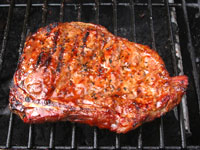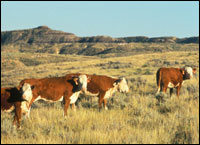Lose That Extra Weight … While Eating the Foods You Love!”

Pleased to meat you.
For decades, such headlines were fixtures of supermarket checkout lanes, to be taken no more seriously than claims of alien abduction. But times have changed. High-protein, low-carbohydrate diets have become wildly popular because they help adherents lose dozens of pounds without having to gnaw on rice cakes.
It seems too good to be true, and some critics say it is. The debate over the long-term health effects of Atkins and similar weight-loss plans might grind on for years with no satisfactory conclusion. But whenever we’re faced with a fast-growing trend on this shrinking planet, scientists should look beyond human health to weigh ecological consequences as well. That’s what we decided to do for Atkins-style diets.
We started with the Worldwatch Institute’s estimate that 1 billion of Earth’s inhabitants are overweight and assumed that on average they eat 56 grams of animal protein a day. That is the average in Western countries, and most overweight people eat Western diets.
If all of those people went on an Atkins-style diet, their requirement for animal protein would rise to about 100 grams. A billion dieters each eating an extra 44 grams could not easily be satisfied by giving them a bigger share of current animal protein production. As it is, humans worldwide average only 28 grams per day. Instead, by our calculations, the meat, dairy, poultry, and seafood industries would have to increase output by 25 percent.

Don’t get caught bread-handed.
The dieters would no longer get much of their protein from plant sources (grains being too heavily “polluted” with carbohydrates), so less cropland would be required for that. Still, the net result of their big switch to animal protein would require almost 250 million more acres for corn, soybeans, and other feed grains. That’s because feeding grain to animals and then eating the resultant meat, milk, eggs, or farm-raised fish is much less efficient than eating plant products directly. (Cattle in particular are good at converting grain into wastes like carbon dioxide, methane, and manure. With worldwide per capita grain production in decline since the 1980s, that bovine talent is less well appreciated by the planet’s hungrier people.)
Finding a quarter-billion acres for adequate feed grain harvests would mean at least a 7 percent increase in cropland worldwide at a time when farmers are already using most of the better land. Much of the newly plowed acreage would likely be marginal, prone to greater erosion, and subject to extra generous applications of fertilizer and pesticides.
Furthermore, feeding that grain to all those extra animals would lead to greater air and water pollution from feedlots, poultry and hog confinement operations, and slaughterhouses. Trying to spare the land and squeeze more protein from the already-overfished oceans would likely be even more damaging.

No ruminant at the inn.
Photo: USDA.
And that’s not all. Cattle and other ruminant animals, whose numbers would have to rise by 25 percent to supply our dieters, get a large share of their food from pasture and rangeland. If most of the additional animals were raised on current range and pasture that are already fully stocked, the result would be overgrazing and degradation. If new pastures were to be created for, say, half of the additional animals, a billion more acres would have to be found. Most of this would probably be obtained by deforestation, which could mean that 10 percent of the Earth’s remaining forests would have to go.
It’s unlikely that all 1 billion of the world’s overweight people will have the desire or the means to make the move to expensive animal-based food. Nevertheless, the kind of ecological damage we have described will occur in direct proportion to the number of people who do adopt the diet.
It is possible, with considerable ingenuity and effort, to achieve the intake of protein, fat, carbohydrates, and fiber recommended by Atkins while on a wholly vegetarian diet. But, for all but a very few dieters and tofu enthusiasts, meals consisting largely of vegetable protein would not mean “eating the foods you love.” Without that enticement, the key to Atkins’ popularity is missing.
So menus and grocery aisles will continue making room for more animal protein. Already, industry analysts are giving much of the credit for sharply higher beef and egg prices to high-protein, low-carb dieters. Stepped-up production is sure to follow.
While it’s true that overconsumption in the industrial West doesn’t exactly qualify as “breaking news,” we’re now seeing a new twist to an old story. The obesity epidemic, caused largely by excess food consumption, has proven to be one of our society’s most vexing problems. The diets now in vogue may be a breakthrough in addressing obesity, but their success entails even greater consumption of global resources.


